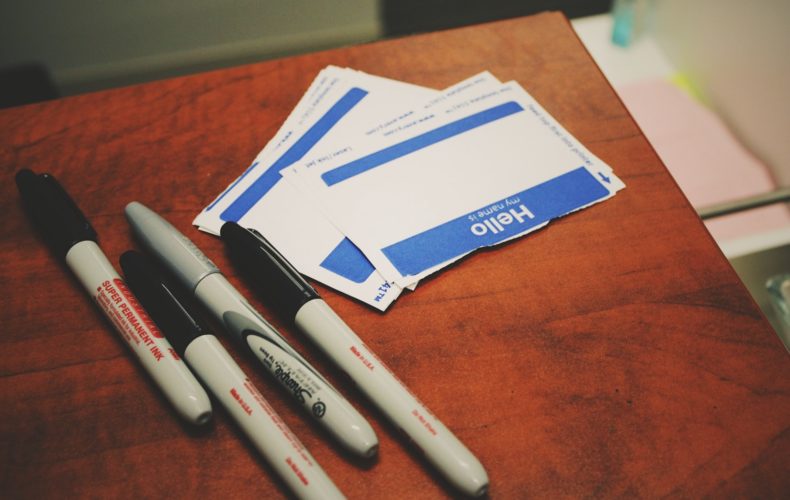Networking is one of the best ways to add to your arsenal of professional contacts, helping you to gain new leads and ultimately land sales. Whether you’re attending a large industry conference or a more informal mixer, striking up conversations with like-minded individuals is a tried-and-true method for finding new opportunities and, because face-to-face meetings are more personal in nature, can give you an edge over the competition. You might even make a few new friends in the process! As important as networking is, it doesn’t come naturally to a lot of people, who might be apprehensive about talking to strangers. Developing a strategy in advance will help improve your networking skills and ensure a successful event. In no time at all, you’ll look forward to the opportunity to meet new people!
Successful networkers know the most important step is the introduction. They say you only have one chance to make a first impression, so make yours count! Smile, shake hands, and maintain eye contact as you share your name and a few brief details about your company. Once you’ve gotten the pleasantries out of the way, everything else will fall into place.
Have a Plan of Action
Do your homework in advance by setting goals you hope to achieve at the networking event and a solid plan for making them happen. Research who will be attending and come up with a list of people you want to meet; these can be individuals you have met in the past but want to strengthen your bond with, as well as new contacts—industry colleagues you admire, leaders you’d like to glean advice from, etc.
Come Prepared with Questions
Standing around awkwardly and waiting for others to approach you is a recipe for failure. Take the initiative yourself by walking up to others and asking a simple question. There’s no need to wow them with an interesting anecdote; a simple “Mind if I join you?” is a great, low-key icebreaker. From there, ask questions designed to help you learn more about the other person. If you’ve researched attendees beforehand, you’ll already have a mental list of questions you can draw from.
Choose Your Location Carefully
Where you stand during a networking event might seem like a trivial matter, but it can help you establish connections with other attendees. Avoid hovering near the entrance; people want time to settle in and check out their surroundings rather than being bombarded with questions immediately upon their arrival. Pick a spot near the bar instead; people will already have a drink in hand and should be more relaxed and ready to interact. When waiting for a drink or food yourself, take the opportunity to converse with others standing in line around you. This is an effortless, laid-back way to start a conversation—and if it doesn’t go well, you can bow out gracefully once you’ve been served.
Forge a Personal Connection
Don’t launch into a sales pitch upon meeting somebody. Instead, keep the conversation light and informal; your main goal is to develop relationships, not close sales. Use the other person’s name several times to establish a friendly rapport. Don’t monopolize the conversation or interrupt when they are talking; express a genuine interest in the other person by asking questions about their personal interests and hobbies and actively listening while they speak. Business talk can happen later (maybe even after the event).
Be Savvy with Business Cards
Even in today’s digital age, business cards are still the most popular way to exchange contact information at a networking event. Keep them in a convenient location such as the breast pocket of your coat or the outside pocket of your purse so you aren’t fumbling around with them. One trick savvy networkers use is to keep their business cards in one pocket and other people’s cards in the opposite pocket. When handing out a card, personalize it with a brief note or alternate contact method; this will make the recipient feel special. After receiving a business card, jot down a note on the back, such as where you met or what you discussed, to help jog your memory later.
Leverage Social Media
Not all networking involves face-to-face meetings. Take advantage of the popularity of social media by researching similar individuals in your industry or reaching out to contacts you’d like to get to know better. Commenting on a link or post is a great way to start a conversation; later, when you meet in person, you’ll already have developed a rapport. LinkedIn and Twitter are the social platforms best geared toward career-minded individuals.
Follow Up
Your work isn’t over once the networking event has wrapped up—it’s actually just beginning! Be sure to follow up with your contacts in order to develop lasting relationships with them. People are busy, especially if they’ve been out of town or tied up with event logistics, so send a brief email 24 to 48 hours after the event reminding them of who you are and recapping your conversation. This opens the door for future dialogue. Follow up regularly—once a month is recommended for people you are trying to build a business relationship with—by sending along relevant information, sharing potential opportunities, or even just wishing them a happy birthday.
Networking is an art, but with a little practice, you’ll become a pro!




